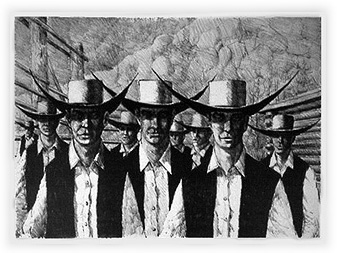| "Montana
Men" by Ben Steele
|
Ben Steele Lithograph, 1988 Born to pioneer ranching parents, Ben Steele grew up in the Bull Mountains northeast of Billings. Steele describes his bonding to the Montana landscape as a wedding rooted in his early years helping out on the family ranch and tending sheep camps. "Compassion for the way nature works and for her creations" is the way Steele himself describes his fundamental attitude as an artist. More than mere regionalism, he believes this emotive underpinning for his art stems from his Montana origins but reaches beyond them to strike a universal chord. That broader resonance is nowhere better seen than in Steele's World War II work. After high school and a stint working ranches, Steele served in the U. S. Army Air Corps from 1940 to 1946. He fought and was captured on Bataan, made the infamous Death March and was interned by the Japanese for 42 months. His visual record of that time - 80 drawings and 5 oil paintings - is the only known diary of prison camps on Bataan and Corregidor. It has toured major cities in the United States and attracted national attention. The collection reflects Steele's intense, respectful honesty - one of the "musts" he believes an artist is obliged to strive for. "Honored" to be included in the Rattlesnake Valley Press Centennial Portfolio, Steele in "Montana Men" obviously reflects the treasure state and those who have shaped it. These are the men who, in Steele's words, are "sturdy, self-reliant . . . proud of where they live and what they do." Head-on they confront the viewer with a directness and honesty characteristic of what Steele calls "next year country men." But typical of Steele's global intuition they could be men of the land anywhere, at anytime. Steele is presently Professor of Art Emeritus at Montana State University--Billings. He holds undergraduate degrees in art from Kent State University and Denver University. His distinguished teaching career spans over three decades and his work is in both private and public collections throughout the United States. --From the Rattlesnake Valley Press Centennial Issue, 1989, Margaret Mudd |

